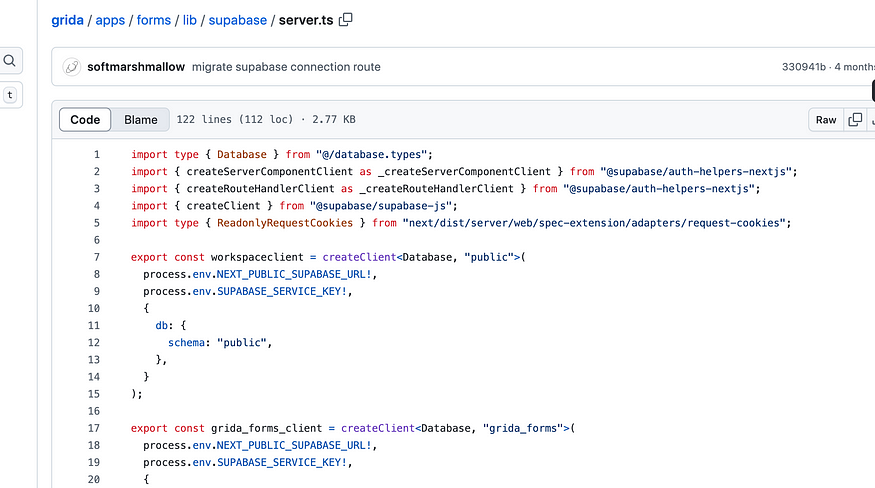Custom schema specific Supabase Server Component clients in Grida Form workspace
In this article, we review the code in server.ts in Grida. Well, what’s so special about this file? let’s find out.

Server Component Client
Before we look at Grida Forms server.ts, Let’s first understand what a Server Component Client means.
In the Supabase Auth guides, at step 3, you will find the information about Server Component Client and it has the below code.
import { createServerClient } from '@supabase/ssr'
import { cookies } from 'next/headers'
export async function createClient() {
const cookieStore = await cookies()
return createServerClient(
process.env.NEXT_PUBLIC_SUPABASE_URL!,
process.env.NEXT_PUBLIC_SUPABASE_ANON_KEY!,
{
cookies: {
getAll() {
return cookieStore.getAll()
},
setAll(cookiesToSet) {
try {
cookiesToSet.forEach(({ name, value, options }) =>
cookieStore.set(name, value, options)
)
} catch {
// The `setAll` method was called from a Server Component.
// This can be ignored if you have middleware refreshing
// user sessions.
}
},
},
}
)
}
Server Component client — To access Supabase from Server Components, Server Actions, and Route Handlers, which run only on the server.
So far, I have reviewed Supabase Server Component Client in Nextjs-Subscription-Payments example and Midday.ai but I have never seen multiple Server components clients defined in the same file like in Grida Form server.ts
Grida Form server.ts
Grida Form server.ts has multiple Server Component clients defined.
workspace client
At line 7, you will find the below code:
export const workspaceclient = createClient<Database, "public">(
process.env.NEXT_PUBLIC_SUPABASE_URL!,
process.env.SUPABASE_SERVICE_KEY!,
{
db: {
schema: "public",
},
}
);
Grida Forms Client
At line 17, you will find the below code:
export const grida_forms_client = createClient<Database, "grida_forms">(
process.env.NEXT_PUBLIC_SUPABASE_URL!,
process.env.SUPABASE_SERVICE_KEY!,
{
db: {
schema: "grida_forms",
},
}
);
Grida Sites Client
At line 27, you will find this below code:
export const grida_sites_client = createClient<Database, "grida_sites">(
process.env.NEXT_PUBLIC_SUPABASE_URL!,
process.env.SUPABASE_SERVICE_KEY!,
{
db: {
schema: "grida_sites",
},
}
);
Grida Commerce Client
At line 37, you will find the below code:
export const grida_commerce_client = createClient<Database, "grida_commerce">(
process.env.NEXT_PUBLIC_SUPABASE_URL!,
process.env.SUPABASE_SERVICE_KEY!,
{
db: {
schema: "grida_commerce",
},
}
);
Grida XSupabase Client
At line 47, you will find the below code:
export const grida_xsupabase_client = createClient<
Database,
"grida_x_supabase"
>(process.env.NEXT_PUBLIC_SUPABASE_URL!, process.env.SUPABASE_SERVICE_KEY!, {
db: {
schema: "grida_x_supabase",
},
});
All these clients are located in a single file — grida/apps/forms/lib/supabase/server.ts
createClient imported
At line 4 in server.ts, you will find the below import
import { createClient } from "@supabase/supabase-js";
But is this same as what is provided in the Supabase Auth Documentation? Nope. You will find the below import in Supabase Auth Docs.
import { createServerClient } from '@supabase/ssr'
Wait, so Supabase Auth Docs tells us to use @supabase/ssr and Grida Forms workspace uses @supabase/supabase-js. Do you know why?
In order to configure your Supabase client with a custom schema, you will have to use @supabase/supabase-js. Using Custom Schema Guide has the following example code snippet provided:
// Initialize the JS client
import { createClient } from '@supabase/supabase-js'
const supabase = createClient(SUPABASE_URL, SUPABASE_ANON_KEY, { db: { schema: 'myschema' } })
// Make a request
const { data: todos, error } = await supabase.from('todos').select('*')
// You can also change the target schema on a per-query basis
const { data: todos, error } = await supabase.schema('myschema').from('todos').select('*')
You will find the clients in Grida Form server.ts have the same syntax for defining the db schema.
About me:
Hey, my name is Ramu Narasinga. I study large open-source projects and create content about their codebase architecture and best practices, sharing it through articles, videos.
I am open to work on interesting projects. Send me an email at ramu.narasinga@gmail.com
My Github — https://github.com/ramu-narasinga
My website — https://ramunarasinga.com
My Youtube channel — https://www.youtube.com/@thinkthroo
Learning platform — https://thinkthroo.com
Codebase Architecture — https://app.thinkthroo.com/architecture
Best practices — https://app.thinkthroo.com/best-practices
Production-grade projects — https://app.thinkthroo.com/production-grade-projects